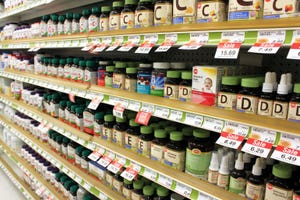ChromaDex's Rebecca Idoine and Yusrah Ishtiaq delve into the science of nicotinamide riboside (NR), as well as the role of NAD+ in healthy aging.

The unyielding aspiration to delay the effects of aging remains a timeless pursuit ranging from the legendary Fountain of Youth to the latest advancements in anti-aging research.
Among the many scientific breakthroughs in this field, one molecule has emerged as a promising candidate: nicotinamide riboside (NR). As a member of the B-vitamin family, NR is garnering increasing attention for its role in maintaining cellular vitality and potentially ameliorating age-related diseases.
The B vitamins, a group of water-soluble vitamins, are each imbued with distinct roles in various cellular processes. These vitamins are crucial for various metabolic reactions within the body and include B1 (thiamine), B2 (riboflavin), B3 (niacin), B5 (pantothenic acid), B6 (pyridoxine), B7 (biotin), B9 (folate) and B12 (cobalamin).
Within this group, NR is classified under the B3 category and serves as a precursor to nicotinamide adenine dinucleotide (NAD+), an essential coenzyme present in all living cells. NAD+ plays an instrumental role in a multitude of cellular processes, encompassing energy production, cellular repair and gene regulation. Emerging research is highlighting how a deficiency in NAD+ can precipitate compromised cellular function, a phenomenon intrinsically associated with aging and age-related diseases.
NR’s journey from obscurity to scientific prominence is a testament to human curiosity and scientific ingenuity. This compound was first identified in the early 20th century around 1944 as a growth factor for the bacteria Haemophilus influenza. Its early discovery left it relatively overlooked until the mid-2000s when researchers, led by Dr. Charles Brenner, began to unravel its hidden potential, and discovered the pathway through which NR is converted into NAD+. More specifically, they uncovered the enzymes that eukaryotic cells—or cells with a nucleus (found in all animals, plants, fungi and unicellular organisms)—use to convert NR to NAD+, unveiling a two-step pathway coined the “NRK pathway.”
Role of NAD+ in healthy aging
With the increasing scientific prominence of NR, there has been a larger, concurrent surge in the understanding of its close partner, NAD+. This uptick in the importance of NAD+ has unfolded at a pace that highlights its growing association with aging and age-related diseases. Its emergence as a potential central player in aging is due to its two primary functions, cellular energy production and repair.
During cellular respiration, NAD+, as well as its reduced form, NADH, participate in oxidation-reduction reactions that help generate adenosine triphosphate (ATP), the body’s primary energy currency. Without sufficient NAD+, this cycle can be impacted, leading to reduced energy production and cellular function.
NAD+ also plays a pivotal role in cellular repair mechanisms. It serves as a substrate for different classes of repair enzymes called poly (ADP-ribose) polymerases (PARPs) and sirtuins that consume NAD+ to carry out their repair functions. The activity of these repair enzymes has been shown to increase with age and exposure to metabolic stressors, contributing to a concomitant decline in NAD+.
Previously believed to be a conserved cellular resource, NAD+ depletion is increasingly associated with age, exposure to metabolic stressors and disease. Excess alcohol consumption, prolonged UV exposure, immune stress and a sedentary lifestyle are among the metabolic stressors linked to NAD+ depletion.
Repeated bouts of exposure to these metabolic stressors have been shown in preclinical and clinical research to depress cellular and tissue NAD+ levels, contributing to dysfunction and disease.
Across a wide range of organisms, spanning from single-celled yeast to mice and humans, scientists have consistently observed a decrease in NAD+ levels as these organisms age. While the debate lingers on about the fundamental cause of this decline, whether it arises from chronological aging or the gradual accumulation of stressors, it is increasingly evident that NAD+ is not a constant resource.
Further, its depletion contributes to a wide range of age-related dysfunctions, including dysfunctional mitochondria, increased inflammation, decreased cellular resilience and impaired cellular repair. These changes are associated with the development of various age-related diseases, such as neurodegenerative disorders like Parkinson’s disease, and cardiovascular diseases, such as heart failure.
Understanding the impact of these metabolic stressors and diseases on NAD+ levels is crucial for developing strategies to mitigate their effects and potentially restore NAD+ homeostasis.
Strategies to maintain/boost NAD+
Given the central role of NAD+ in healthy aging, and its increasing association with age-related disease and dysfunctions, strategies to maintain or augment its levels have spurred an intensive pursuit of scientific research. Several strategies have emerged as promising means to achieve this, including lifestyle behaviors such as engaging in moderate exercise and calorie restriction, as well as dietary supplementation with NAD+ precursors.
Supplementation with precursors, or building blocks of NAD+, is an additional way to increase NAD+ levels outside of moderate exercise and calorie restriction. Perhaps the most direct and potent way to increase NAD+ levels, these precursors are compounds that can be converted into NAD+ within our cells. Several common NAD+ precursors exist and have been available as supplements, including NR, nicotinamide mononucleotide (NMN) and NAD+ itself. However, there are a few key differences between them, including their ability to cross the cellular membrane directly.
NAD+ is a larger molecule that degrades quickly when exposed to light and heat and deteriorates when exposed to water. Additionally, NAD+ is a large, phosphorylated molecule, and thus, cannot cross the cellular membrane directly. Like NAD+, NMN is a large, phosphorylated molecule that cannot cross the cellular membrane directly. Instead, NMN must be converted into NR before crossing the cellular membrane. Both NAD+ and NMN are inefficiently broken down into smaller precursor constituents, like NR, outside of the cell and rebuilt within the cell to increase NAD+.
NR, on the other hand, can cross the cellular membrane directly, making it the most efficient precursor to increase NAD+ levels. As previously stated, NR utilizes the NRK pathway to increase NAD+ levels, allowing its unique properties to differentiate it from the other precursors. Some of these unique properties include not inducing flushing at high doses or inhibiting sirtuins as other precursors are known to do. The NRK pathway is also activated in response to cellular stress events since cells require additional levels of NAD+ for elevated repair and energy demands.
Niagen NR
The science behind NR is ever-growing, substantially due to the ChromaDex External Research Program (CERP). Established in 2013, the CERP team works with independent, third-party-funded investigators from leading universities and research institutions worldwide to uncover the full potential of NAD+. Since its founding 10 years ago, this program has helped achieve over 275 independent, third-party-funded research agreements with investigators at over 200 global institutions. These agreements have resulted in over 150 peer-reviewed publications, including 28 peer-reviewed clinical studies, on Niagen, a patented form of NR.
Preclinical and clinical studies conducted through CERP have demonstrated the efficacy and safety of NR in various animal models and human populations. These studies include the effects of NR on immune, muscle, gut, neurological and cardiovascular health, among others. Notable peer-reviewed, published clinical studies on Niagen are summarized here:
- Zhou et al., 2020 – “Boosting NAD level suppresses inflammatory activation of PBMCs (peripheral blood mononuclear cells) in heart failure,” showed NR supplementation increased whole blood NAD+ levels and mitochondrial respiration rate of the heart failure patients’ PBMCs. NR reduced the production and gene expression of proinflammatory cytokines and the systemic inflammation in heart failure patients was causally linked to mitochondrial function of the PBMCs.
- Veenhuis et al., 2021 – “Nicotinamide riboside improves ataxia scores and immunoglobulin levels in ataxia telangiectasia (AT),” concluded NR supplementation improved ataxia scores (SARA and ICARS). However, this improvement disappeared after NR withdrawal, indicating a temporary, symptomatic effect of NR in AT. NR also markedly increased serum immunoglobulin G (IgG) in immunodeficient patients.
- Wu et al., 2022 – “Boosting NAD+ blunts TLR4-induced type I IFN in control and systemic lupus erythematosus monocytes,” showed NR reduced cytokine expression and type-I interferon (IFN) signaling (which plays an important role in the human immune response) in monocytes from healthy subjects and SLE patients. Oral NR supplementation replicated the effects observed with ex-vivo NR administration.
- Brakedal et al., 2022 – “The NADPARK study: A randomized phase I trial of nicotinamide riboside supplementation in Parkinson's disease,” determined NR supplementation significantly increased cerebral NAD+ levels, altered brain metabolic pattern, and decreased levels of inflammatory cytokines in the cerebrospinal fluid of PD patients. Moreover, patients experienced a mild but significant clinical improvement, and this correlated with the change in the brain’s metabolic pattern.
- Wang et al., 2022 – “Safety and tolerability of nicotinamide riboside in heart failure with reduced ejection fraction,” demonstrated that high-dose NR supplementation was safe and well-tolerated, significantly, and dose-dependently (nearly) doubled whole blood NAD+ levels and increased peripheral blood mononuclear cell (PBMC) mitochondrial respiration. NR also decreased expression of inflammatory markers.
- Lapatto et al., 2023 – “Nicotinamide riboside improves muscle mitochondrial biogenesis, satellite cell differentiation, and gut microbiota in a twin study,” demonstrated in BMI-discordant twin pairs, NR supplementation was well-tolerated and increased whole blood NAD+ levels. NR also increased muscle mitochondrial biogenesis and improved gut microbiota composition, as seen through an increase in the abundance of Faecalibacterium prausnitzii—one of the most beneficial bacteria found in the microbiome of healthy humans.
Over 95% of studies conducted via CERP are independent, investigator-initiated and third-party funded. All lots of Niagen undergo comprehensive testing consisting of 22 internal and third-party tests to ensure potency, safety and purity. Moreover, Niagen is manufactured under current good manufacturing practices (cGMP) conditions in an ISO-accredited facility.
Niagen also been reviewed by regulatory authorities in the U.S. and several countries abroad. It is the only proprietary form of NR twice notified to the U.S. Food and Drug Administration as a new dietary ingredient (NDIN 882; NDIN 1062) without objections from the agency and generally recognized as safe (GRAS).
In addition to receiving approval for use in medical foods by the Brazilian Health Regulatory Agency (ANVISA), Niagen has been approved for use in food supplements by the European Commission, complementary medicines by the Therapeutic Goods Administration of Australia (TGA), and medical foods by the Food Standards Australia New Zealand (FSANZ). Finally, Tru Niagen has also been approved by Health Canada as a natural health product.
Read more about:
Supplement scienceAbout the Author(s)
You May Also Like








.png?width=800&auto=webp&quality=80&disable=upscale)